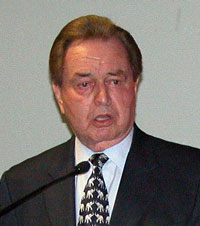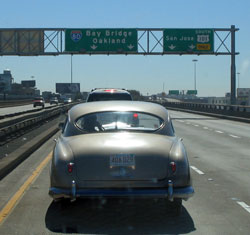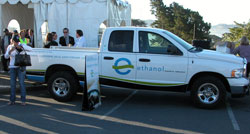 When we got to Reno, NV today our first stop was the National Automobile Museum. We were welcomed by state Senator Bill Raggio.
When we got to Reno, NV today our first stop was the National Automobile Museum. We were welcomed by state Senator Bill Raggio.
Senator Raggio said good things about the highway system and that there are challenges looking into the future, especially as it relates to issues like funding.
You can listen to Sen. Raggio here:  Nevada Sen. Bill Raggio Remarks (4 min MP3)
Nevada Sen. Bill Raggio Remarks (4 min MP3)
Domestic Fuel coverage and participation in the AASHTO Interstate 50th Convoy is sponsored by the Ethanol Promotion and Information Council.


 As is normally the case for me when I’m out and about, I’ve got way more pictures than I can ever post for you. At the conclusion of this 2 week cross country adventure I’m going to post a Flickr photo album for you that will have lots of interesting photos.
As is normally the case for me when I’m out and about, I’ve got way more pictures than I can ever post for you. At the conclusion of this 2 week cross country adventure I’m going to post a Flickr photo album for you that will have lots of interesting photos. This is what my view was like as we left San Francisco this morning. Looking at the rear end of a vintage Hudson. I’ll have more on it and the driver in a future post.
This is what my view was like as we left San Francisco this morning. Looking at the rear end of a vintage Hudson. I’ll have more on it and the driver in a future post.
 One of the primary sponsors of the cross country interstate celebration is
One of the primary sponsors of the cross country interstate celebration is  I just missed the ribbon cutting ceremony after which we had to start our engines and take off on the highway today. It was held in front of this truck which proudly displays the reason we’re travelling cross country this month.
I just missed the ribbon cutting ceremony after which we had to start our engines and take off on the highway today. It was held in front of this truck which proudly displays the reason we’re travelling cross country this month. Kicking things off this morning for the AASHTO cross country convoy was our U. S. Secretary of Transportation, Norman Mineta.
Kicking things off this morning for the AASHTO cross country convoy was our U. S. Secretary of Transportation, Norman Mineta. This is the San Francisco skyline behind the staging area for this morning’s convoy kickoff. It was a beautiful sunrise on the bay.
This is the San Francisco skyline behind the staging area for this morning’s convoy kickoff. It was a beautiful sunrise on the bay. Hello from Reno, NV. This is our first stopping point on the road to Washington, DC. It’s been a great day for the kickoff of the AASHTO Celebrate The Interstate Convoy.
Hello from Reno, NV. This is our first stopping point on the road to Washington, DC. It’s been a great day for the kickoff of the AASHTO Celebrate The Interstate Convoy.
 The
The